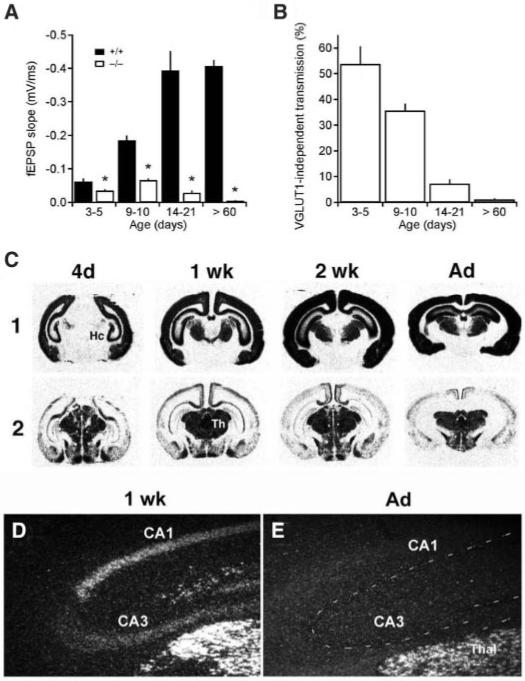Fig. 2.

Developmental changes in VGLUT1-independent transmission correlate with the transient expression of VGLUT2 in hippocampal pyramidal neurons. (A) fEPSP slopes measured at a fiber volley amplitude of 0.25 mV increase with age in wild-type mice, but decline in VGLUT1-/- mice after postnatal day 9 to 10. Differences between wild-type and VGLUT1-/- mice are significant (*, P < 0.001). Error bars show mean + SEM. (wild type, n = 15 to 40; VGLUT1-/-, n = 18 to 43). (B) VGLUT1-independent synaptic transmission expressed as a percentage of the wild type (at a fiber volley amplitude of 0.25 mV) constitutes a larger percentage of excitatory synaptic transmission in hippocampi from younger mice and declines through development. Each bar represents the data collected from 15 to 43 slices; error bars show mean + SEM. (C) In situ hybridization from the developing mouse brain with 35S-labeled VGLUT1 and two antisense RNA probes. VGLUT1 expression increases progressively from 4 days (4d) to adulthood (Ad). In contrast, VGLUT2 expression does not change in the thalamus but reaches a peak at 1 week (1 wk) in the hippocampus, followed by a rapid decline and disappearance by adulthood. Hc, hippocampus; Th, thalamus. (D and E) Darkfield microscopy of sections hybridized with 35S-labeled antisense VGLUT2 RNA and dipped in autoradiographic emulsion shows substantial labeling of the pyramidal cell layer in CA1 to CA3 from 1-week-old (D) but not adult (E) wild-type mice. In the adult, the pyramidal cell layer is indicated by a dashed line, and the thalamus (Thal) serves as a control for the labeling.
